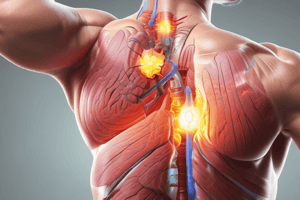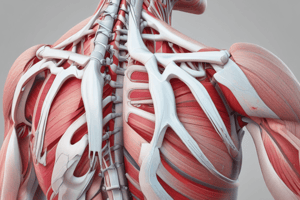Podcast
Questions and Answers
What is characterized by high pain (> 7/10) and high disability on DASH, ASES, Penn Shoulder Score?
What is characterized by high pain (> 7/10) and high disability on DASH, ASES, Penn Shoulder Score?
What is the primary focus of scapular stabilization in the given image?
What is the primary focus of scapular stabilization in the given image?
Which of the following is NOT a characteristic of Low Irritability?
Which of the following is NOT a characteristic of Low Irritability?
What is the primary difference between Moderate Irritability and High Irritability?
What is the primary difference between Moderate Irritability and High Irritability?
Signup and view all the answers
What is the significance of nighttime pain in irritability classification?
What is the significance of nighttime pain in irritability classification?
Signup and view all the answers
In which type of irritability does AROM equal PROM?
In which type of irritability does AROM equal PROM?
Signup and view all the answers
What is the typical range of subacromial space in patients with shoulder pain?
What is the typical range of subacromial space in patients with shoulder pain?
Signup and view all the answers
What is a common cause of primary shoulder impingement syndrome?
What is a common cause of primary shoulder impingement syndrome?
Signup and view all the answers
What is the name of the test that involves palpating the scapula to assess its position and movement?
What is the name of the test that involves palpating the scapula to assess its position and movement?
Signup and view all the answers
What is the name of the test that involves elevating the arm in the scapular plane to assess for impingement?
What is the name of the test that involves elevating the arm in the scapular plane to assess for impingement?
Signup and view all the answers
What is the name of the test that involves asking the patient to elevate the arm in the scapular plane and then quickly lowering it?
What is the name of the test that involves asking the patient to elevate the arm in the scapular plane and then quickly lowering it?
Signup and view all the answers
What is the name of the muscle that is often weak or hypomobile in patients with shoulder impingement syndrome?
What is the name of the muscle that is often weak or hypomobile in patients with shoulder impingement syndrome?
Signup and view all the answers
What is the name of the joint that is often involved in shoulder impingement syndrome when pain is present between 120-180 degrees of arm elevation?
What is the name of the joint that is often involved in shoulder impingement syndrome when pain is present between 120-180 degrees of arm elevation?
Signup and view all the answers
What is the term for abnormal movement patterns of the scapula and glenohumeral joint?
What is the term for abnormal movement patterns of the scapula and glenohumeral joint?
Signup and view all the answers
What is the primary cause of a 'SICK' scapula?
What is the primary cause of a 'SICK' scapula?
Signup and view all the answers
Which of the following is a characteristic of a 'SICK' scapula?
Which of the following is a characteristic of a 'SICK' scapula?
Signup and view all the answers
What is the term for the condition where the medial border of the scapula protrudes from the posterior chest wall?
What is the term for the condition where the medial border of the scapula protrudes from the posterior chest wall?
Signup and view all the answers
Which of the following muscles is often tight in patients with a 'SICK' scapula?
Which of the following muscles is often tight in patients with a 'SICK' scapula?
Signup and view all the answers
What is the term for the condition where the glenohumeral joint is unstable in multiple directions?
What is the term for the condition where the glenohumeral joint is unstable in multiple directions?
Signup and view all the answers
Which of the following is a type of scapular stabilizer?
Which of the following is a type of scapular stabilizer?
Signup and view all the answers
What is the term for the condition where the coracoid process is very tender to palpation?
What is the term for the condition where the coracoid process is very tender to palpation?
Signup and view all the answers
Which of the following is a sign of a 'SICK' scapula?
Which of the following is a sign of a 'SICK' scapula?
Signup and view all the answers
Study Notes
Causes of Shoulder Impingement Syndrome
- Rotator cuff weakness
- Superior labral lesions
- Force couple imbalances
- Scapular malposition (SICK scapula)
- Inferior medial border prominence
- Coracoid pain and malposition
- Dyskinesis of scapular movement
Types of Disorders
- BONY: Thoracic kyphosis, Clavicular fracture nonunion/malunion
- JOINT: AC instability/arthrodesis, Glenohumeral internal rotation deficit (GIRD)
- NEUROLOGICAL: Cervical radiculopathy, Long thoracic nerve palsy, Spinal accessory nerve deficit
- SOFT TISSUE: Intrinsic muscle pathology (1°, 2°, or 3° strain), Hypomobility (e.g., short head of biceps, pectoralis minor)
- MYOGENIC: Limb girdle muscular dystrophy (LGMD), Facioscapulohumeral dystrophy (FSHD)
Signs and Symptoms of "SICK" Scapula
- Insidious onset
- Prominence of inferomedial border of scapula
- Protraction of scapula
- Acromion less prominent
- Coracoid very tender to palpation
- Tight pectoralis minor
- Lack of full forward flexion
- Tight short head of biceps
- Winging of the medial border of the scapula
Scapular Tests
- Scapular Assistance Test
- Scapular Retraction Test
- Flip Sign
- SAT (scapular retraction tests)
Shoulder Impingement Syndrome
- Subacromial space: 7-13 mm in patients with shoulder pain, 6-14 mm in normal shoulders
- Causes of Primary and Secondary Shoulder Impingement Syndrome:
- Abnormal glenohumeral arthrokinematics
- Abnormal scapulothoracic arthrokinematics
- Capsule tightness
- Inflammation in the subacromial space
- Degeneration of the rotator cuff tendon
- Adhesions
- Osteophytes under the AC joint
- Hooked acromion
- Muscle weakness or fatigue
- Muscle hypomobility
- Hypermobility of the glenohumeral joint
Impingement Tests
- Yocum Impingement Test
- Hawkins-Kennedy Impingement Test
- Neer's Impingement Sign
Clinical Pearls
- Hawkins-Kennedy test, painful arc sign, and positive infraspinatus test are best for anterior impingement
- Painful arc sign, drop-arm test, and infraspinatus test are best for full-thickness rotator cuff tears
- Painful arm between 60 to 120 degrees is suggestive of impingement, while pain between 120 to 180 degrees is indicative of AC joint involvement
Supraspinatus Testing
- "Empty can" manual muscle test
- "Champagne toast" test
Infraspinatus, Teres Minor, and Subscapularis
- Posterior capsular tightness
- Scapular stabilization with the torso perpendicular to the examining table
Irritability Classification and Treatment Strategies
- High Irritability: High pain (> 7/10), consistent night or resting pain, high disability on DASH, ASES, Penn Shoulder Score
- Moderate Irritability: Moderate pain (4-6/10), intermittent night or resting pain, moderate disability on DASH, ASES, Penn Shoulder Score
- Low Irritability: Low pain (< 3/10), no resting or night pain, low disability on DASH, ASES, Penn Shoulder Score, minimal pain at end ROM with overpressure
Studying That Suits You
Use AI to generate personalized quizzes and flashcards to suit your learning preferences.
Description
This quiz covers common injuries and dysfunctions related to the rotator cuff, including scapular malposition, labral lesions, and muscle imbalances. Test your knowledge on the diagnosis and treatment of these conditions.




